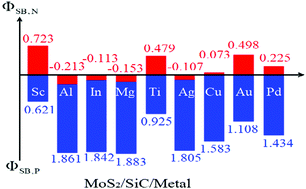Non-invasively improving the Schottky barrier of MoS2/metal contacts by inserting a SiC layer†
Abstract
The applications of two-dimensional (2D) materials in electronics, optoelectronics, and spintronics are limited by the high contact resistance at the metal/semiconductor interface owing to the strong Fermi-level pinning. In this study, an interlayer insertion strategy is proposed to solve this problem, and first principles calculations are done to study the influences of inserting a SiC layer on the Schottky barrier and electronic properties of MoS2/metals (Mg, Al, In, Cu, Ag, Au, Pd, Ti, and Sc). The average charge value substantially increased (≥0.060 e) at the interface between SiC and MoS2 layers, and then no tunneling barrier appeared except for the MoS2/Au contact by inserting the SiC layer. Moreover, ΦSB,N almost decreases for the MoS2/metal contacts by inserting the SiC layer. When Ti, Cu, Au, and Pd are used as electrodes, the n-type Schottky barrier is formed with the ΦSB,N values of 0.479 eV, −0.073 eV, 0.498 eV, and 0.225 eV, respectively. However, if Al, In, Mg, and Ag are used as electrodes, the systems are transformed into Ohmic contact. These findings provide a practical guideline for depinning the Fermi level at contact interfaces and designing the high performance TMD-based nanoelectronic devices.



 Please wait while we load your content...
Please wait while we load your content...